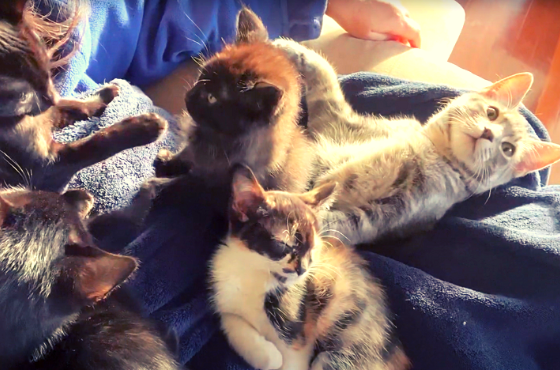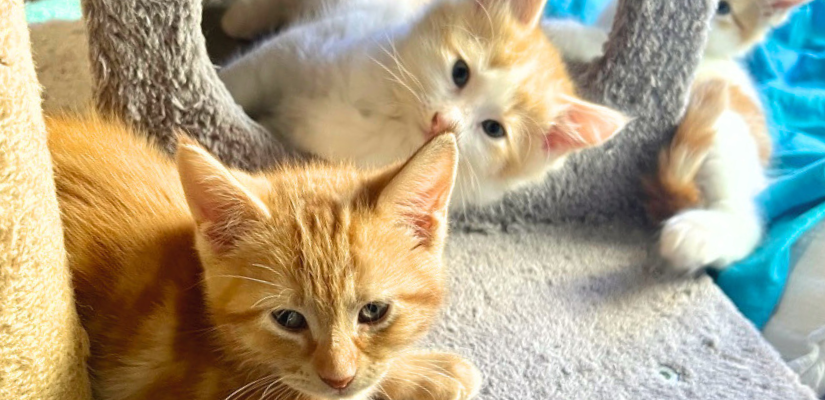Welcoming a new feline friend into your home or fostering environment can be an exciting yet delicate process, especially when you already have a resident cat.
Ideally, the two cats will become instant best friends – but unfortunately, due to the nature of felines, this often isn’t the case. Instead, thoughtful and gradual introductions are the keys to fostering harmony between your feline companions.
Foster carers can be fostering many cats at a time, which means it’s helpful if they get along and don’t cause issues with each other. Some cats will never like other cats and will need to be in a single cat household. While being fostered they may need their own room in order to prevent costly vet bills. Today, we’ll share our step by step method on how to introduce cats.
A Guide to Introducing Cats to Each Other
Why Cats Need Slow Introductions
Cats, by nature, are solitary animals with a strong sense of territory. So the older they get the more likley they are to fight with other cats to claim territory. Unlike dogs, they don’t always thrive in the company of other creatures initially. Understanding the reasons behind the need for slow introductions can significantly contribute to a successful and harmonious multi-cat household.
- Territorial Instincts: Cats are territorial creatures, and introducing a new cat can be perceived as an intrusion. Each cat establishes a territory where they feel safe and secure. Invading this territory without proper introductions can lead to stress and aggression.
- Hierarchy Establishment: Cats, especially those unfamiliar with each other, may engage in a process of establishing a hierarchy. Rushing this process can lead to conflicts.
- Stress Avoidance: Cats are sensitive to changes in their environment, and a sudden introduction can cause stress responses like hiding, aggressive behaviour, or refusal to eat.
- Individual Personalities: Every cat has a unique personality, and some may be more sociable than others. Slow introductions accommodate these individual differences, giving each cat the time they need to feel comfortable.
- Preventing Traumatic Experiences: A traumatic introduction, characterised by aggressive encounters or excessive fear, can leave lasting negative impressions. Slow introductions aim to prevent such negative experiences and build a foundation of mutual acceptance.
In essence, the gradual introduction process we’ll teach you acknowledges and respects the intrinsic nature of cats. By allowing them the time and space to adapt at their own pace, you’re laying the groundwork for a positive and lasting relationship between your feline companions.
How to Introduce Cats Slowly
Step 1: Setting the Stage for Success
Before the initial face-to-face meeting, it’s crucial to establish separate spaces for each cat. These designated areas should include essentials such as food and water bowls, litter boxes, cozy bedding, and hiding spots. Choosing strategic locations for these spaces is equally important. There should be a door between them to ensure the cats can’t bother each other in this initial phase. Each cat needs to feel secure and have a refuge to retreat to when needed.
Step 2: Scent Exchange
Cats heavily rely on scent for communication. Facilitate scent exchange by swapping bedding or gently rubbing a soft cloth on one cat and then allowing the other cat to investigate it. Also holding each cat and getting the scent on your clothes helps them to associate the smell with you and safety. This helps them become familiar with each other’s scents before direct interaction. Ideally, this stage should last several days at least, until you can see that both cats are settled and aren’t already anxious.
Step 3: Gradual Visual Introduction
Once you feel that both cats are settled and can handle a new introduction, gradual visual exposure is the next step. Consider cracked door interactions or using a baby gate to allow visual contact while maintaining a physical barrier. Observe their reactions closely, paying attention to body language to ensure they are comfortable with this initial visual interaction. It is normal at this stage for them to hiss at each other and to swipe. One cat may lay down to show submission to the other cat.
Sometimes one cat will lunge at the other with ears pinned back. This is an indication that you might need to go back to step 2 for awhile or that you might have a very territorial cat.
Step 4: Controlled Face-to-Face Meetings
Once visual interactions are going smoothly, progress to controlled face-to-face meetings. Keep these initial encounters short and supervised. Positive reinforcement, such as treats or gentle strokes, can be used to reward calm behaviour. If stress levels rise, separate the cats and slow down the introduction process. You can also put the new cat in a pet playpen or enclosure in the main area. This way they can see and smell each other but there is a barrier and put the playpen against a wall or corner so there is always space for them to retreat.
Step 5: Playtime as a Bonding Activity
Interactive play is a powerful tool for fostering positive associations between the cats. Use toys that both cats enjoy and engage them together. Play helps to reduce tension and build a sense of camaraderie. Here are some play ideas:
- Catnip Infused Toys: Catnip can be a powerful bonding agent. Use catnip-infused toys during joint play sessions. The shared enjoyment of catnip can create positive associations.
- Feather Wands: Engage both cats in interactive play using feather wands. The unpredictable movements mimic prey, providing an outlet for their natural hunting instincts and promoting joint play.
- Interactive Laser Pointers: A laser pointer can be a fantastic tool for engaging both cats simultaneously. The elusive red dot triggers their hunting instincts, and they may enjoy chasing it together.
- Rolling Toys with Treats: Incorporate treat-dispensing rolling toys into playtime. This not only keeps them physically active but also associates positive experiences with each other’s presence.
- Tunnels and Hideaways: Create an environment that encourages hide-and-seek play. Tunnels and hideaways provide spaces for both cats to explore, play, and even surprise each other.
Step 6: Feeding Time as a Unifying Ritual
Associating mealtime with positive experiences can further strengthen their bond. Feed both cats in proximity but at a safe distance, gradually decreasing the space between them. Shared meals create positive associations and contribute to a harmonious environment.
Step 7: Recognising Signs of Compatibility
Observe the cats for signs of compatibility and readiness for increased interaction. Positive behavioural cues, such as relaxed body language and shared spaces, indicate growing acceptance. Be attentive to any signs of stress or tension and, if needed, seek guidance from a professional cat behaviourist.
Experiences from Fostering
- Kittens can be introduced to other kittens and older cats more quickly
- When female cats are on heat they love all cats so it can be a great time to introduce them to male cats that have been desexed or other female cats. This helps to form a bond that continues when the cat is no longer in heat
- I had one cat that would bolt out of her room and run around the house and wack the other cats as she ran past. She would charge at the perspex door if she saw another cat outside. She was super scared of other cats and so would attack 1st. She had to have her own room the whole time she was with me and was adopted to a household where she was the only cat.
- Two other cats were fine at first but then they started chasing the shy cats and fighting them in tumbling brawls. These cats were here at different times and needed there own rooms. They were adopted to households where they were the only cat.
- Boy and girl cats will often pair up. That might be litter mates or cats not known to each other. So provided at least one of them is desexed it can help to have equal numbers of girls and boys or just girls or just boys.
Introducing two cats is a journey that requires time, patience, and understanding. Celebrate small victories and progress, no matter how incremental. The reward of witnessing two cats form bonds and coexist harmoniously is well worth the effort.
Remember, each cat is an individual with unique preferences, so adapt the introduction process to their specific needs. With persistence and positive reinforcement, you can create a thriving multi-cat household where feline friendships flourish.

Are you looking to adopt a pet or donate to a pet rescue organisation? Georgie and Cindy from Large Hope SEO foster cats and kittens on the Sunshine Coast in Australia. If you’re local, get in touch to discuss adopting from the rescues. See cats and kittens available for adoption or donate so we can save more kittens.
 seolounge
seolounge